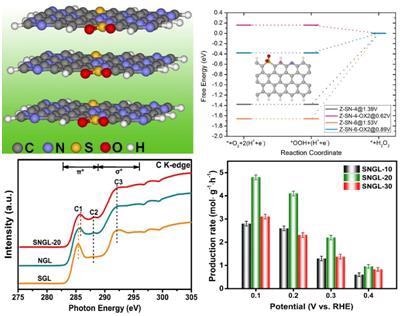The energy- and waste-intensive anthraquinone oxidation (AO) process is used to manufacture hydrogen peroxide (H2O2), which is one of the world’s 100 most important chemicals.
 Illustration of the research. Image Credit: Prof. GUAN’s Group
Illustration of the research. Image Credit: Prof. GUAN’s Group
The use of inexpensive and effective catalysts is required to replace the AO approach with a more ecologically friendly electrochemical two-electron oxygen reduction reaction (2e- ORR).
However, as a prospective contender, a metal-free, carbon-based catalyst only performs well in neutral or alkaline conditions, where H2O2 is unstable for collection or undesirable for linking applications, such as the e-Fenton reaction. Furthermore, identifying the genuine active catalytic sites and the underlying 2e- ORR mechanism remains difficult.
A research group led by Prof. Lunhui Guan from the Chinese Academy of Sciences’ Fujian Institute of Research on the Structure of Matter developed a metal-free, highly efficient acidic 2e- ORR catalyst with a record hydrogen peroxide production rate based on pyrimidine-assisted active site modulation and S, N-codoped few-layered graphene for valence electronic optimization in a study published in Chem Catalysis.
In acid, the catalyst showed excellent activity and selectivity for 2e- ORR. Over a potential range of 0.20~0.55 V, the H2O2 selectivity approaches 90%~100%, and the maximal H2O2 production rate (4.8 mol·g-1·h-1) outperforms all documented H2O2 production performance for carbon material-based catalysts.
Experiments and density-functional-theory simulations revealed that the combined oxidized sulfur and pyridinic-N functional motif can lower the Fermi level of valence electronic states of active edge carbon sites, resulting in a suitable binding strength of *OOH intermediate for high selectivity and performance 2e- ORR for H2O2 formation.
With S integration, the researchers saw a clear peak shift to the high energy of C 1s excitation in the near edge X-Ray absorption fine structure, providing good evidence for valence electronic optimization of the carbon catalyst surface.
It can also degrade a model organic pollutant (methylene blue [MB], 50 ppm) to colorless in just 15 minutes when combined with the Fenton reaction for an electron-Fenton procedure.
This research not only develops an effective carbon-based catalyst for H2O2 generation in acid but also gives a valuable electronic property optimization approach for future carbon-based catalyst tuning.
Journal Reference:
Xu, J, et al. (2022) Pyrimidine-assisted synthesis of S, N-codoped few-layered graphene for highly efficient hydrogen peroxide production in acid. Chem Catalysis doi/10.1016/j.checat.2022.04.011